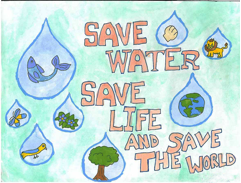
"Water Water everywhere
But not a drop to drink!"
These lines of Coleridge seem to be so true in today’s context. Water is one of the most important natural resources available on this earth, or rather, in this whole world. We need it for every other activity in our daily lives, be it for drinking, cooking, cleaning or washing and what not!!! Yet we take water for granted most of the time, despite clearly knowing the fact that our water supply is limited. 97% of all the water on the earth is salt water which is not suitable for drinking. Only 3% of all the water is fresh water, and only 1% is available as drinking water.
Water is the very foundation meof life. As the most intelligent and responsible beings dwelling on this earth, it is our duty to conserve water and preserve its quality for our future generations. Water conservation reduces the efforts and energy required to process and deliver water, which in turn helps in reducing pollution and in conserving other natural resources. It is also the most effective and environmental friendly method to fight global warming!

Water conservation needs to be a way of life, not just something that we think about once in a while. We can start this from our own kitchens. For instance, when washing dishes by hand, we should not leave the water running for rinsing. If there is a double-sink, we should fill one sink with soapy water and the other with rinse water or if there is a single sink, we should gather dishes in a dish rack and rinse them with a spray or panful of hot water. For dishwashers, there is usually no need to pre-rinse the dishes. One should also ensure that the dishwasher and clothes washer should be fully loaded for optimum water conservation. Hence it is very important that we start reducing wastage by using right methods, products and appliances in our kitchens.
Kent RO Systems Ltd is one such company that is the pioneering manufacturer of products in the area of water purification and conservation. Its unique product, the
Kent tap guard is a cutting-edge innovation that prevents wastage of water in the filtering process itself. Another product by
Kent is the Vegetable & Fruit Purifier, which ensures water conservation along with healthy washing of vegetables and fruits without the need of running tap water. The water used for rinsing fruits and vegetables can also be reused to water houseplants.
Every drop counts. Water conservation is not a job that is limited to the scientists, hydrologist, foresters, and farmers alone. It is a personal responsibility for each of us. We all must make a conscious commitment to change our lifestyles to conserve water. Maybe one day Coleridge will be forced to change his lines altogether…
"Water Water everywhere
And every drop to drink!"















.png)
.png)




